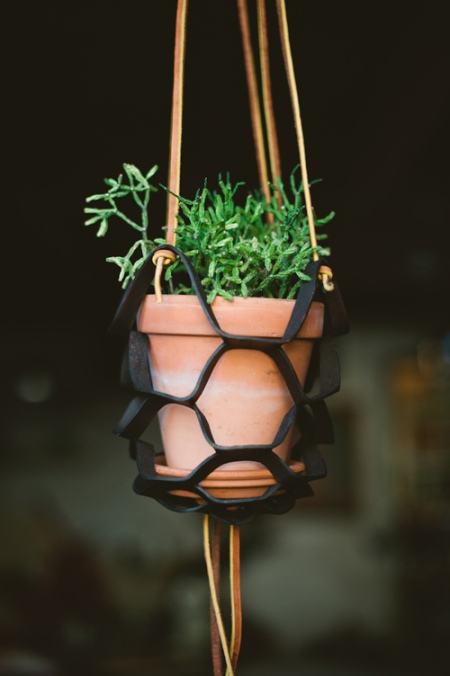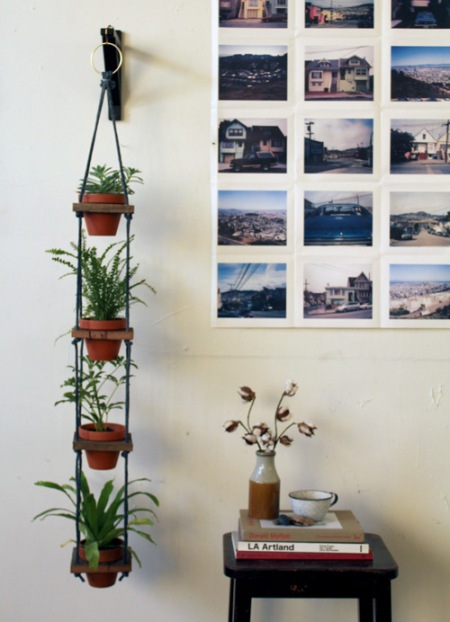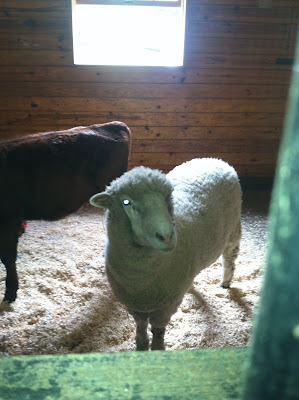
As someone who only celebrates Christmas through my husband and his family, it is tempting to kitsch it up with a pink plastic tree, but that wouldn’t be very sustainable, now would it? Instead I chose to buy a potted norfolk pine and decorate it with scraps of ribbon from work and leftover yarn from crochet projects. I would have loved to plant it outside when the weather gets warm again, but since it’s made for the semi-tropics, I’ll probably be reusing it every year inside the house. For those of you debating the merits of a real tree vs an artificial one, read this article from Organic Gardening:
The allure of an artificial Christmas tree is obvious: reusable, dependably lush and symmetrical, and best of all, mess-and maintenance-free. But convenience has an environmental price tag, making fresh, fragrant, real trees a better choice. Artificial trees are made from materials such as polyvinyl chloride (PVC) and metal and are often imported from China. Because they cannot be recycled, artificial trees end up in landfills when they are no longer useful.
They are also questionable in terms of human health. California Proposition 65, a law that protects consumers from exposure to toxic and cancer-causing substances, requires artificial trees made in China to have a warning label about the potential of lead poisoning. A 2008 report to the U.S. Environmental Protection Agency on children’s exposure to lead noted, “Artificial Christmas trees made of PVC degrade under normal conditions. About 50 million U.S. households have artificial Christmas trees, of which about 20 million are at least nine years old, the point at which dangerous lead exposures can occur.”
Real Christmas trees, in contrast, are grown on farms in all 50 states, taking up to 15 years to reach harvestable size. During that time, they improve air quality by emitting oxygen, and they provide habitat for wildlife—often on ground that is unsuitable for other crops, such as steep slopes and areas beneath power lines.
“Real trees are an important conservation crop,” says Tom McNabb of Yule Tree Farms, a wholesale grower in Oregon. McNabb points out the environmental superiority of oxygen-producing trees “versus a product made from petroleum with additives like lead to keep the needles pliable and which returns toxic gas into the atmosphere during production and disposal.”
In 2007, some of the largest U.S. Christmas tree growers formed the nonprofit Coalition of Environmentally Conscious Growers. Member growers employ sustainable practices and planting methods that promote good care of the land, including riparian and wetland management. Natural barriers, buffer zones, and vegetative cover protect ditches and streams and contribute to healthy watersheds. Growers use natural and mechanical methods to control pests and competing weeds. The 2007 Census of Agriculture from the USDA reported that of the more than 343,000 acres of Christmas trees grown in the United States, only 4 percent used supplemental irrigation.
Real trees have postholiday value, too, as communities collect and recycle them to turn into mulch, use them as erosion barriers, or sink them in ponds for fish habitat.
Click here to learn how to reuse or recycle a real Christmas tree after the holidays.
Spread the Green(ish) Word:
Christopher A. Nevala, 7, smashes leftover Halloween pumpkins with a mallet during the (Com)Post Halloween event at Zenda Farms in Clayton on Saturday afternoon. Photo by Amanda Morrison for the Watertown Daily Times.


 Photo from
Photo from 










![2057-0-4[1]](https://fthats.files.wordpress.com/2011/10/2057-0-41.jpg?w=450)
![1220125_wheat_field[1]](https://fthats.files.wordpress.com/2011/10/1220125_wheat_field1.jpg?w=450)

![conservespan600[1]](https://fthats.files.wordpress.com/2011/08/conservespan6001.jpg?w=450)
![FISH-2-articleLarge[1]](https://fthats.files.wordpress.com/2011/08/fish-2-articlelarge1.jpg?w=450)

![066L-to-do-list-go-green[1]](https://fthats.files.wordpress.com/2011/07/066l-to-do-list-go-green1.jpg?w=450)
![fresh-vbe3md[1]](https://fthats.files.wordpress.com/2011/06/fresh-vbe3md1.jpg?w=450)